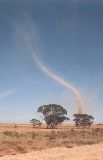 |
Chasing:
What is it really like?
Chasing. What's it like? Is it really like what I saw in Twister? Does a storm chaser
really get to chase tornadoes 24 hours a day? Those are questions that I get asked quite
frequently these days. I'll attempt to answer those interrogatives in this article.
First of all, it IS NOT like what you see portrayed on the big screen. Instead, it's
filled with long hours spent on the road, with precious few minutes of action. The movie
Twister gives the impression that a tornado lurks around each corner, and every second is
action packed. That's bogus. Doesn't happen. Movies are not real! That movie also would
lead one to believe that you can be caught by an F-5 tornado and live to tell about it.
Wrong. The odds of winning the state lottery are better. Don't
misunderstand...I liked Twister, it's just that when you watch the movie, you're looking
at typical Hollywood hype.
Prowling the high plains in search of tornadoes can be a very enjoyable hobby, but it
helps if you have a real love for weather, and don't mind seeing a lot of America in the
process. The movie Twister spawned hordes of new chasers, bent on bagging the big ole F-5
at any cost. I know they were out there. I saw them lined up bumper-to-bumper on the
roads, and I also saw the hail-battered shells of their vehicles after they were pounced
upon by some of the monster storms of the plains. The reduction of vehicles at recent
chaser convergence's is probably proof that some of those newbies decided it wasn't so
cool after all.
Be prepared for long, boring drives across America. You get to see a lot of country, and,
if you notice, a lot of subtle differences about how our fellow citizens live. Plan on
driving hundreds, if not up to a thousand miles per day in search of tornadoes. Most storm
chases will end up empty-handed, commonly called a 'bust' day.
A typical chase day begins early in the morning, analyzing weather data over the Internet.
The chaser looks at the day 1 and day 2 severe weather forecasts from the Storm Prediction
Center, along with surface and upper air charts. The storm chaser makes a forecast, and
then embarks on his trip. After a long, boring drive, the chaser arrives at his forecasted
target area, and usually sits for a couple of hours, until convection begins to initiate.
Sometimes, he will get updated weather information, and modify the forecast somewhat.
Others will opt to receive the latest radar images, to better examine storms.
After a storm is targeted, close attention is paid to its appearance and behavior during
its development. Vital clues in the clouds give good indications about whether or not the
storm has the potential to develop a tornado. As it matures, the chaser will look for a
wall cloud or lowering to form at its base, and then use his judgment about how to track
the storm, or to give up and head for greener pastures.
For many, the big prize is seeing a tornado. Most would agree that the average success
rate is around 10%. Nevertheless, at the end of the day, the storm chaser faces a long
drive home, sometimes through heavy rain and vivid lightning, from the storms he pursued
earlier. |


